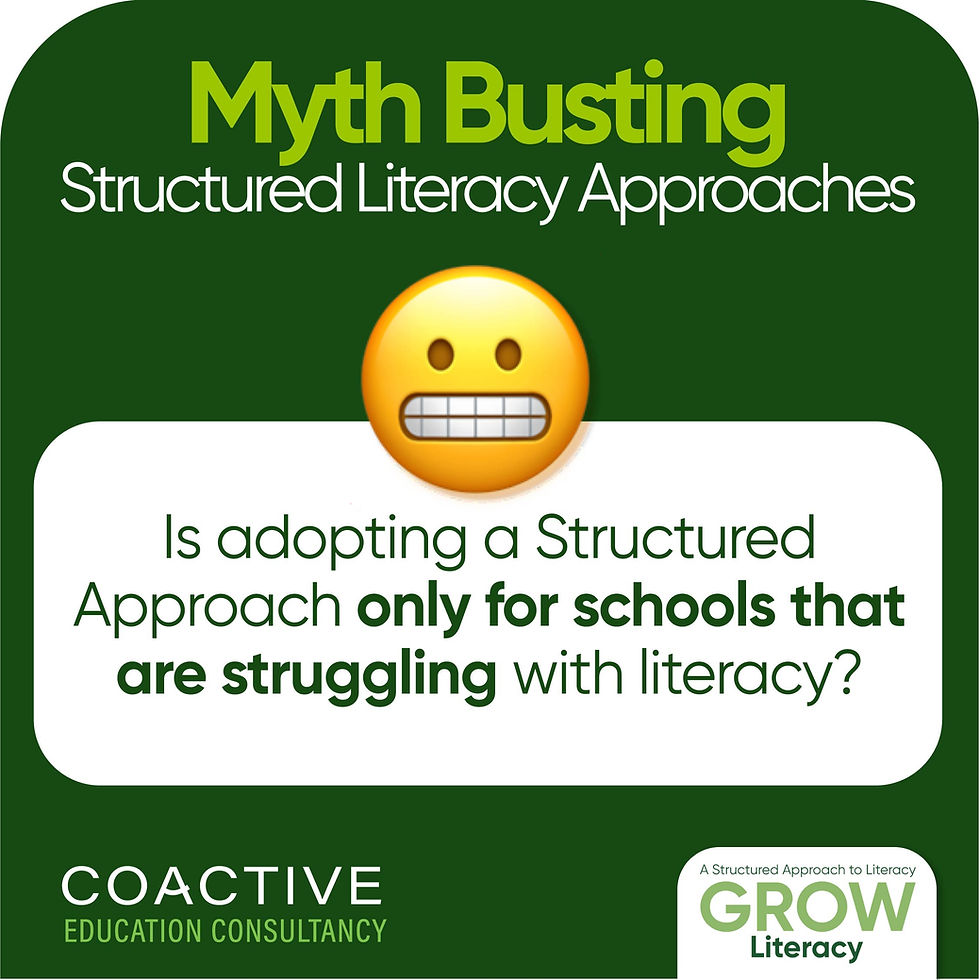Dispelling the Myths: The Truth About Structured Literacy Approaches (SLA) PLD
- Del Costello

- Jul 15
- 4 min read

At Coactive Education, we work alongside schools every day to strengthen their literacy practice through Structured Literacy Approaches (SLA). Despite increasing awareness of evidence-based literacy instruction, there are still several persistent myths about what SLA PLD involves and who it is for. These misconceptions often limit the impact schools and teachers can achieve through this work.
Drawing on our experience delivering the GROW Literacy PLD, we want to address these myths and offer a clearer picture of how high-quality Structured Literacy PLD supports meaningful change in practice and outcomes.

Myth 1: Structured Literacy Approaches PLD is Only for Struggling Schools or Leaders
One of the most common misunderstandings we encounter is the belief that SLA is only necessary for schools with significant literacy challenges or for teachers who are not performing well. In reality, Structured Literacy is about embedding consistent, explicit teaching practices that benefit all learners, regardless of a school’s starting point.
Schools engaging with SLA are often those who are committed to refining and deepening their literacy practice. They understand that high-quality literacy instruction is not static and that ongoing improvement is part of delivering excellent outcomes for every learner. Structured Literacy provides teachers with the tools to teach explicitly, to scaffold effectively, and to support learners to build foundational skills with clarity and confidence.
Through our GROW Literacy PLD, we work with schools at every stage of their journey. Our approach supports teachers to embed routines for handwriting, spelling, sentence construction, and vocabulary development alongside strategies for comprehension and writing fluency. Activities such as the Desert Island Game (see page 3 of the GROW Literacy Workshop 3 resource) help all students to strengthen phonological awareness within an engaging, explicit framework.

Myth 2: Three Days of PLD Cannot Create Lasting Change in Teacher Practice
This myth reflects a misunderstanding of how effective professional learning works. Isolated one-off workshops are unlikely to lead to sustained change, but well-designed PLD, structured over time with clear connections to daily classroom practice, does lead to long-term impact. This myth also assumes that teachers know nothing and that simply is not true. They bring with them a wealth of prior knowledge, an open mindset and a willingness to do their best. They are open to responding to evidence and a strong desire to support literacy progress.
Our GROW Literacy PLD is intentionally designed to demonstrate and allow teachers to experience what it feels like to learn in a Science of Learning setting. We allow teachers to build onto their prior knowledge and practice over time. Teachers engage in structured workshops, followed by Communities of Practice that maintain momentum and provide opportunities for reflection and shared problem-solving. Our Resource Hub offers practical tools, templates, and guidance to support implementation between sessions. Beyond this PLD, we offer the opportunity for our facilitators to work alongside teachers in classrooms to model strategies, observe practice, and offer feedback that reinforces learning. We are constantly mindful of cognitive load for our teachers.
This is not about front-loading knowledge in a single event but about supporting teachers through a carefully scaffolded process. Teachers revisit and refine key routines across multiple sessions, handwriting practice, sentence structure work, or targeted reading strategies for learners who need additional support. These small, consistent adjustments in daily practice are what create meaningful and sustained change. The activities and approaches outlined in the resource, such as Random Capitals for handwriting (see page 8), demonstrate how even seemingly simple strategies can build fluency and accuracy over time.

Myth 3: Structured Literacy is Overly Theoretical and Lacks Practical Strategies for the Classroom
A frequent concern from teachers unfamiliar with Structured Literacy is that it focuses too heavily on theory without offering actionable strategies. In fact, Structured Literacy is deeply practical. It thrives on clear, explicit routines and activities that can be implemented immediately and consistently.
Our GROW Literacy PLD provides teachers with ready-to-use strategies that are embedded within their existing programmes. For example, our workshops support teachers to implement the scope and sequence of Te Mātaiaho ELA, to refine handwriting fluency routines, to strengthen sentence construction through sentence starters and conjunction scaffolds, and develop comprehension skills through activities such as story maps, inference charts, and reciprocal reading. These activities are not theoretical; they are proven, practical strategies that can be used in classrooms the very next day.
Examples from our workshop resource illustrate this clearly. Teachers are equipped with structured approaches to reading fluency, comprehension, and writing, with tools such as paragraph planners and peer feedback protocols explicitly designed to support manageable and incremental progress. These activities are carefully aligned with current research on literacy development and the principles of the Science of Learning. They are designed to build teacher capability through repeated, intentional practice supported by ongoing feedback.
Conclusion: Structured Literacy PLD is for Every School Committed to Strengthening Practice
Structured Literacy is not a programme to purchase and implement in isolation. It is a way of teaching that brings clarity, consistency, and research-based practice into everyday classroom instruction. Through GROW Literacy PLD, we help teachers translate theory into practice through scaffolded, ongoing support that leads to sustained change. To become pedagogical experts!
This professional learning is for schools and teachers who are committed to continuous improvement. It is for those who recognise that even well-established practice benefits from reflection, refinement, and fresh ideas. Most importantly, it is for those who want to ensure their literacy instruction delivers the best possible outcomes for all learners.



Comments